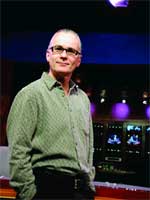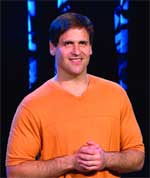
Conrad W. Denke CEO The Victory Studios www.victorystudios.com Seattle/LA
|
The HDTV forecast for 2003 is bright. Costs are falling, awareness is rising, and investment is holding steady. Watch for the possibility of mild trepidation to dampen an otherwise picture-perfect new day. But, expect this suspicion to pass over quickly once the fog engulfing HD lifts.
STRENGTHS: HD doesn't disappoint. When people shoot with it for the first time, they're often amazed by its economy, flexibility and quality. While HD was off to a slow start, we're now seeing a geometric progression in its adoption. Every new convert converts someone else. As the HD medium gains momentum, the field of people with solid HD experience is growing, and this expertise benefits the industry.
WEAKNESSES: There are many misperceptions about HD. If people are operating under erroneous assumptions, they can't make sensible decisions about the best way to use it. Recently, our Los Angeles facility was posting a half-hour HDTV sitcom pilot that had been shot on 24p HD for ABC primetime. There was a scene that the director wanted to shoot very dark. But when they got to post, they were dismayed because it was so dark you couldn't really see the unique props. They decided the shot was unusable. But, as I pointed out to them, HD has tremendous depth, and there's a lot of picture information that can be pulled up from the darkness. So, we lightened it up. The props were now visible and they put the scene back into the show.
If you're shooting 35mm film and your scene is too dark, when you try to bring it up, all you get is noise. That's not the case with HD. As people gain experience with HD, they can make better decisions.
OPPORTUNITIES: HD is enabling people to get their foot in the door at a much higher level. Film is too expensive and DV lacks a film look, but HD is affordable with near-film quality. Recently, we edited an 18-minute short for a group of film students from USC. It's a musical. That's noteworthy because musicals tend to be very expensive because big dance numbers require many takes, which really add up when you're rolling 35mm. By shooting in HD, the kids from USC were able to produce a really fantastic musical.
THREATS: The biggest threat to HD is that it's perceived as a threat - to people's jobs and the status quo in Hollywood. There's a concern that unions, the FCC, or those with a "studio mentality" might try to rigidly or narrowly define how HD can be used rather than letting the market fully explore HD.

Smokey Forester Distribution Manager Science Bulletins American Museum of Natural History http://sciencebulletins.amnh.org New York
|
Victory Studios has many HD services, including telecine, multiformat editorial, graphics, and Dolby 5.1Surround Sound capabilities.
STRENGTHS: With its high resolution and clarity, the HD image is compelling. When you enter a public space with a large screen HD display, it's hard not to look at it. It's ideal for documenting scientific events for posterity and for public education because the picture quality is so rich.
HD video allowed our museum audiences to watch gazelles in a migratory area in Mongolia without braving inclement weather or distracting the animals. This is one of the HD video segments our 12-person production crew produced in HDCam (1080/60i) for Science Bulletins, a service that makes HD video featurettes available to subscribing museums to present in a loop on large screens and plasma monitors as an informative attraction in their exhibit halls and visitor centers.
WEAKNESSES Broadcasters haven't embraced HDTV, and it hasn't been presented to the public in a way that fosters a better understanding or stronger demand. Even in consumer electronics stores, retailers often show content that's not HD, such as video playing off DVD players, but they call it "HD," which adds to the confusion.
OPPORTUNITIES: I just came back from a conference called The Association of Science and Technology Centers (ATSC), which is an association of natural history museums and science centers, and there was tremendous interest in HD technology. Panasonic demonstrated HD equipment.
There are also tremendous opportunities for capturing beautiful, rare footage in HD, even in exotic places because it's a very portable, rugged and increasingly affordable medium.
THREATS: Misinformation. People are hearing that 24p HD is a better format than 1080/60i, but it's more expensive to buy or rent. The added cost and complexity act as a deterrent to those who'd be perfectly happy shooting 1080/60i if they weren't made to view it as the inferior HD format.
If I were shooting a feature film, and wanted a film look, I would certainly shoot 24p HD. But, for documentaries or broadcast, 1080/60i is better suited because it doesn't have 24p HD's flicker. Eventually, the industry will migrate to 1080/60p and - without interlacing artifacts - this will produce an even smoother, higher resolution picture.

Randall P. Dark President HDvision Studios www.hdvstudios.tv Studio City, CA
|
The American Museum of Natural History distributes its original HD features to subscribing museums and science centers.
STRENGTHS: With the advent of 24p HD, it's virtually impossible for HD not to be successful in the Hollywood community. Since prices are attractive compared to film, the financial managers of film and television productions are encouraging production people to work with it. With new pilots and independent films, the bottom line is very important. So considering HD's cost effectiveness, I'd be very surprised if any TV pilots or independent films choose 35mm over 24p HD.
There are also many technical advantages to shooting 24p HD versus 35mm film. The HD camera can roll for 40-minutes uninterrupted, whereas film mags need to be re-loaded every 10 minutes. With film, that laborious start and stop, breaks the actors' concentration and interrupts the momentum of performances. In production, directors and DPs can immediately review their HD footage rather than waiting a day or more for the film to be processed and transferred to dailies. That immediacy continues into post production where HD imagery can be edited, manipulated and finished in a realtime environment.
WEAKNESSES: We don't have a 100-year history for HD cinematography the way we do with 35mm film. While we can look back at a century of artistic achievement in the film medium, we've only had HD for a heartbeat. But, because it's so new, there's no telling where the HD medium can go artistically or technically. While we've seen about all the advancements we're going to see with film cameras, stock and analog projectors, we're just on the cutting edge of HD camera, storage and digital projection technology.
OPPORTUNITIES: The biggest opportunities are in digital cinema, where we will see increased flexibility and revenue in what the theatres can show. With "Enhanced Cinema," if there's nothing playing Tuesday night, maybe the cinema can present a medical seminar via satellite featuring the world's leading brain surgeons. Imagine the impact of a live World Cup Soccer match on a 60-foot screen. And, cinema operators will have increased flexibility to change the trailers and movies to be shown on each screen in response to box office results.
THREATS: The threat to HD is the fear factor. There may be a fear of working with an electronic camera. But people will have to learn HD cinematography because it's the way things are going. I would advise people to experiment with it before they start using it because there is a learning curve. Then establish a look and feel for the imagery and stick to it. While it's better to err by over-exposing film, with HD, it's better to err by under-exposing it.

Mark Cuban Co-Founder/Chairman/President HDNet www.hd.net Dallas
|
HDVision Studios serves as a one-stop-shop where HD video is the medium of choice.
STRENGTHS: The prices on HDTV sets are dropping two to five percent per month. And as people need to replace their analog TVs, they'll increasingly find that HDTV is a better way to go. And, by mandating that DTV tuners be built into HDTV sets, the FCC will make it easier for people to receive HDTV over the air, and fuel the DTV transition. Also, by producing and delivering compelling, original HDTV content, cable and satellite providers are also propelling HDTV and giving people a reason to buy sets.
WEAKNESSES: There's a shortage of set-top boxes capable of handling HDTV. While cable and satellite services are offering more HDTV channels and shows, there aren't enough set-top boxes to satisfy demand because every system operator is in a back-order situation. Also, market research firms aren't getting a good picture of the demand for HDTV sets because they aren't asking the right questions. And that leads to another weakness in the industry - showing true HDTV to consumers so they'll know what it is and what's out there to watch.
OPPORTUNITIES: In traditional media, there have been gatekeepers that determine what shows get the "green light" to get made. Well, with HD, the gates are coming down. Affordable HD production is lowering the barrier to entry for many newcomers. With HD, the small guy is now on par with the big guy.
Another opportunity we see at HDNet is the ability to capture and broadcast very rare, valuable HDTV footage of news events from hot spots like Afghanistan, Pakistan, Iraq, Iran and Moscow. Rather than relaying highly compressed, low bit rate video via satellite phone, we're able to show incredibly detailed pictures [on our weekly news program HDNet World Report].
THREATS: The biggest threat to HDTV is "Napsterization," where content providers get so concerned about copy protection that they screw things up legislatively, or prevent HDTV shows from airing, until they have bulletproof copy protection in place. I'm not against copy protection, but I am against legislating how it should be done.
HDNet broadcasts exclusively in (1080/60i) HDTV via DirecTV.